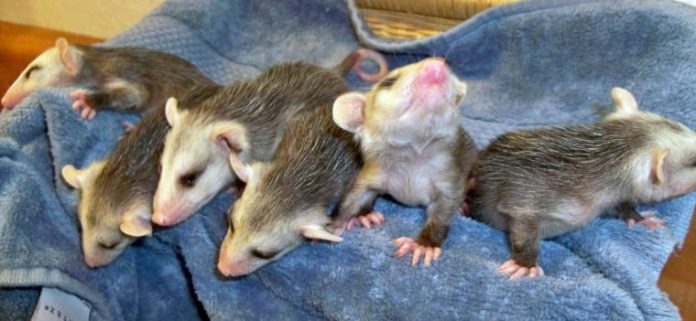
Welcome the first babies of the Wildlife Education and Rehabilitation Center’s “baby season” – six tiny opossums just four-inches long (not counting their tail), all under 50 grams (the weight of two AA batteries) when they arrived with their eyes still closed. They were found on the ground in Gilroy, possibly abandoned because their mother had been killed or maybe she had simply left them for a short time while she foraged for food.
Please note: If you find a baby wild animal, whether bird or mammal, leave it alone (unless it’s in immediate danger) and call a wildlife rehabilitation center for advice in determining whether the young animal is truly orphaned. The baby’s best chance for survival is to be raised by its natural parents. Human surrogates are a far-distant second best.
Because opossums do not suckle, the two male (jacks) and four female (jills) joeys – as opossum babies are called – must be tube-fed a special formula every two to three hours until they are about 100 grams, weaned and eating on their own. Soon after that, they will be transferred to an outdoor enclosure to acclimatize to the weather, climb, exercise and learn how to hunt for food, much as they will be doing in the wild.
In about a month and a half, when they have more than doubled in size to nine inches, the nocturnal critters will be released at nightfall near their original habitat, where they will be able to survive on an omnivorous diet of wild berries, fallen fruit, snails, slugs, frogs, small rodents and carrion – a real benefit to our environment!
Virginia opossums are North America’s only marsupial animal but are not native to California. They were introduced to our state at the turn of the 20th century from the East Coast for food and fur-raising purposes. Over time, some of these animals escaped or were released, and because they are a hardy (though short-lived) and adaptable species, they became well established throughout much of the West Coast and today are a very common sight, even in our suburban backyards.
Opossums are marsupials, like the kangaroo and koala. They are born after 12 days (the shortest gestation of any mammal), then the pink, hairless, bee-sized babies climb into the mother’s abdominal pouch, and remain attached to a nipple for the next 10 weeks. After 11 weeks, the joeys are able to climb in and out of the pouch, holding onto their mother’s fur and tail with their dexterous paws. They have a prehensile tail that helps them balance and keep from falling off mommy.
Opossums are solitary, very rarely aggressive, and will not attack your pets if left alone. If hissing and baring their teeth (50 teeth, more than any other animal) doesn’t scare away a predator (dogs, coyotes, foxes, raccoons, bobcats, eagles, hawks, owls and humans) they will “play sick” by drooling and pooping; if that doesn’t work, they will “play dead.”
Since the opossum does not stay in one location more than a few days, if you don’t want them wandering around your back yard, remove food sources such as fruit on the ground and pet food, and they will soon move on to another location.
•••
Meet Miss Rosie O’Possum, WERC’s educational opossum and artist-in-residence. Critics are raving about her one-of-a-kind, hand-foot-and tail-painted artwork, “Posies by Rosie,” which have been compared to Pollock and Picasso. Her tiny hands and feet make colorful, flower-like impressions on the paper.
The marsupial artist is getting ready for her first art showing and will make a personal appearance to meet the public and present her paintings during WERC’s Wildlife Celebration, from noon to 3 p.m. April 28 at Old Machado School, 15130 Sycamore Ave., Morgan Hill. Her framed artwork will be available for purchase at the event’s boutique. Details: www.werc-ca.org.










